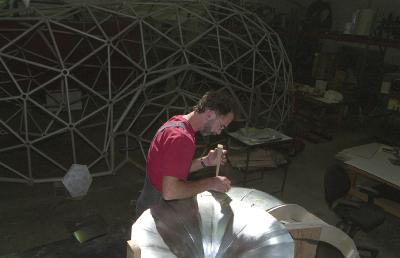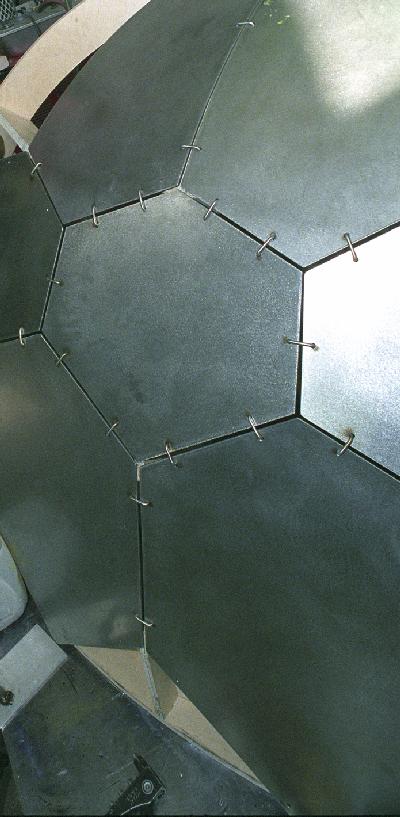August 19, 2004
Artist wants sculpture to ‘hide in plain sight’
Sometime before fall quarter begins a new sculpture will sprout on the Parrington Lawn just south of the new law school. A large, free-form piece made of stainless steel, it actually has a title that fits right in with its academic setting.
“I call it The Department of Forensic Morphology Annex,” said sculptor Cris Bruch. “It’s a field whose time will come and when it does they’ll want to build a building. But they’ll have to start in an annex.”
The title is emblematic of Bruch’s dry wit, but the sculpture is no joke. Thanks to an exterior that consists of dozens of irregular shapes individually welded onto a base, building it has been a laborious process consuming many months.
The sculpture’s underlying structure is a geodesic dome of sorts — tubular pieces connected up in triangles that together form not a dome, exactly, but a variant of it. The “skin” on the outside of that structure is separated from it by about 3 inches and fastened with pins that are about a half-inch in diameter and welded on. Because the overall shape of the underlying structure is not a standard one, the pieces of steel that cover it have to be individually measured and cut to fit as the fabricators build it.
“That’s unusual in public art,” said Kurt Kiefer, campus art administrator. “Usually, everything is figured out in advance, but with this sculpture it had to be done one piece at a time.”
The work-in-progress currently resides at Fabrication Specialties, Ltd., a UW alumni-owned art fabrication company in South Seattle, where Bruch is working with employees to complete the sculpture before moving it to the campus by truck.
“I’ve never built anything like this, but I think it is recognizable as my work,” Bruch said. “I often use a lot of parts and a really intensive process and I’m very interested in different kinds of strength.”
Bruch said he spent a lot of time scrutinizing the site and that what he was going for was a “hidden in plain sight” kind of work.
“I wanted to make connections to both the wind tunnel and the observatory,” he explained. “They’re right out in the open but a lot of people don’t see them. Or they’ve seen them so repeatedly that they’ve forgotten they’re there. That’s always a very interesting thing to me experientially.”
Besides its resemblance to a geodesic dome, the sculpture also calls to mind an igloo, or even a dog lying on its side. Bruch calls it “an animated, mechanical form.” He hopes people will be fooled by the scale — seeing it as either bigger or small than it is. The actual measurements are 23 feet long, 9 feet wide and 8 feet tall.
Kiefer said the skin will have a variety of surface finishes. “Some of the pieces will have this sort of swirly matte-type finish and a few places will be polished shiny,” he said. “And there are gaps in the skin so you’ll be able to see inside. What I’m looking forward to is when the sun is setting and you’re standing on the east side of the sculpture, you’ll be able to look and see sun coming through it.”
The sculpture is funded by the state’s half-percent for art program. On campus, that means that one-half percent of any state money given for construction is pooled and used wherever appropriate, so a piece of art is not necessarily connected to a particular building. In the case of Bruch’s sculpture, Kiefer said the intent was to enhance the 42nd street entrance to the campus.
Bruch called it a “dream commission,” saying that once he was selected he wasn’t given a long list of instructions. “I’ve been given a huge amount of flexibility,” he said.
Kiefer said a dedication of the sculpture will be held sometime in fall quarter.




